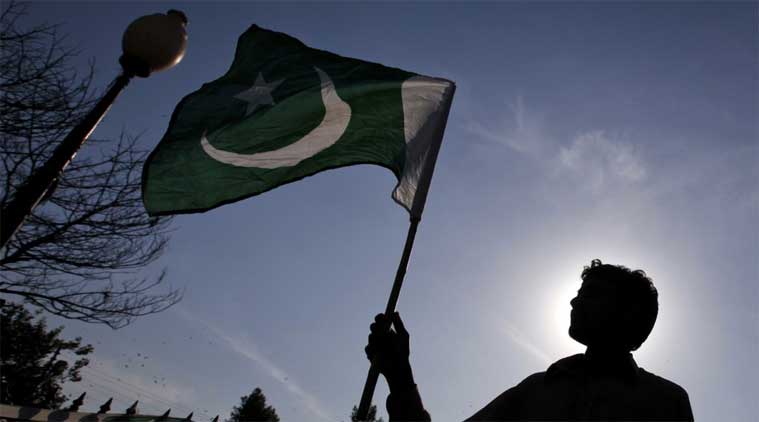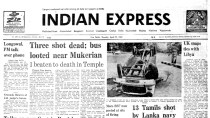- India
- International
The rise of religious rage
A weak state warns the world against blasphemy. It does not act against the threat to itself.
 The big cities in Pakistan are being subjected to expressions of extreme latent violence. In Lahore, the lawyers shouted ‘death to blasphemers’ and cursed the government for not taking action against France.
The big cities in Pakistan are being subjected to expressions of extreme latent violence. In Lahore, the lawyers shouted ‘death to blasphemers’ and cursed the government for not taking action against France.
A self-flagellating but double-edged anti-blasphemy rage has Pakistan in its grip once again. Frontally, it is aimed at the West, but in actual fact it is the clerics’ reaction to the Pakistan army’s recent anti-Taliban drive.
After the Charlie Hebdo massacre in Paris, a weak expiatory regret in the Islamic world has been superseded by familiar paroxysms over blasphemy by the magazine. France was becoming isolated over the application of its “universalist” doctrine on immigrant communities in the face of “multiculturalist” abstention by its neighbours from reprinting the offending cartoons, when the Muslim world jolted the West into its old groove of fear.
The big cities in Pakistan are being subjected to expressions of extreme latent violence. In Lahore, lawyers shouted “death to blasphemers” and cursed the government for not taking action against France. Semi-literate lawyers recommend going to the International Court of Justice (ICJ), if the “impotent” Organisation of Islamic Conference (OIC) won’t listen. No one recalled what happened last time we went to the court against India. The ICJ is a remnant of the League of Nations, and its “optional clause” scuttles its jurisdiction.
The cities are taken over by “religious powers”, as the clerics now call themselves, and business is disrupted through “million marches” and shutter-down strikes. Outside the French consulate in Karachi, a Pakistani photographer working for a French news agency was shot in the chest. The two dozen terrorist organisations in the city that kill citizens for sport watched as the anti-blasphemy vandals expressed their piety through brickbats.
In March 2006, the Danish cartoons, printed a year earlier, caused one of Pakistan’s most historic cities, Lahore, to be put to the torch. The politicians, keen to steal the thunder of the clergy, joined in the anti-cartoon march of the extremists and refused to act as a moderating influence in society. Lahore’s leading cleric, Sarfraz Naeemi of Tahafuz-e-Namoos-e-Risalat Mahaz (Front for the Protection of the Honour of Prophet), staged a blood-curdling protest march in Lahore against Denmark. (He was later killed by a suicide-bomber in a sectarian strike.)
Earlier, Naeemi had taken up arms against the poor Christians of Sangla Hill, charging desecration of the Quran. In November 2005, the Christian community of Sangla Hill in Nankana district in Punjab experienced a most hair-raising day of violence and vandalism that burned down three churches, a missionary-run school, two hostels and several houses belonging to the Christian community. The deed was done by a mob of some 3,000 Muslims.

The Danish cartoons were avenged by destroying Pakistani property. The country was already in a state of shell-shock by the virulence of the Sangla Hill violence. Naeemi said that the vandals had done the right thing. His extreme posture shamed even the jihadist militias. He declared that the Christian clergy had set the churches on fire after the desecration incident, and should be put behind bars and not allowed to leave the country. He warned that he was taking a procession to Sangla Hill to get the Muslims released from jail. He protested against religion minister Ijazul Haq’s statement that Muslims had destroyed the churches.
The rightwing Punjab government thought in 2006 that it could ride with Naeemi to capitalise on Muslim rage and win the 2007 elections. But anything started by Naeemi was hardly going to be peaceful and of benefit to the government. On Lahore’s Mall, the rioters torched hundreds of cars and motorcycles and damaged government buildings and private businesses. Outlets of foreign fastfood companies McDonald’s, KFC and Pizza Hut, as well as several local restaurants and businesses, were attacked and set on fire. Several shops and travel agencies were broken into and looted.
The demonstrators entered the Punjab legislative assembly and torched a room next to the chamber of the opposition leader. After that, they moved on to the Pakistan International Airlines (PIA) building and broke its front. They attacked the hotel Holiday Inn on Egerton Road and the nearby institution dedicated to the national poet, Allama Iqbal, smashing windows and burning cars. On the Mall, Dayal Singh Mansions came in for thorough destruction. The blaze at the KFC restaurant spread to the upper stories of the Coopera Art Gallery, a Muslim Commercial Bank branch, a National Bank branch and a Telenor franchise. The damage was estimated at Rs 4.5 billion.
The rage was suicidal. The ruling party, instead of condemning the rioters, launched a tirade against Denmark and emphasised the importance of Islamic protest. After that, boys from Lahore’s schools and colleges entered the streets with clubs in their hands and set about breaking cars and setting them on fire. The police stood aside watching, probably longing to get into the act of destroying Pakistan. They saw boys get together in a phalanx, firing their guns in volleys.
Intelligence sources later said that the chain of violent incidents was orchestrated by the student wing of the Jamaat-ud-Dawa (JuD, formerly known as the Lashkar-e-Toiba, LeT), among others. (The JuD was to attack Mumbai in November 2008 with its band of terrorists.) Groups of at least 35 men each carried out most of the violence, including burning and ransacking of buildings across Lahore. The main group travelled around in a maroon Jeep and motorcycles, and most of its members had long hair, beards and were clad in commando uniform. The JuD flag hung from the Jeep. All of them were trained and many had been summoned to Lahore from other cities. They were armed with petrol bombs, firecrackers, small weapons and a “fire accelerant” chemical.
Not to be outdone, politicians took out a “silent” procession of parliamentarians in Islamabad, one of them actually threatening violence “the next time round”. It was the government in power in Islamabad that was threatened because a newspaper in Denmark had blasphemed. The European Union, which accounted for 30 per cent of Pakistan’s exports — Pakistan’s largest trading partner together with the United States, accounting for a total 60 per cent of exports — was not the planned target.
In the north of Pakistan, in the Khyber-Pakhtunkhwa province, then chief minister Akram Durrani thought he would let the same kind of thing happen in Peshawar and reap another windfall from the orgy of Islamic passion. Some 60,000 participated in the orgy and torched a KFC franchise, two petrol stations, 16 Daewoo buses, several banks, a police checkpost and offices of the Norwegian mobile phone firm Telenor. One hospital was destroyed because it belonged to the Aga Khan Foundation and everyone considered the Aga Khan’s sect, the Ismailis, to be heretical.
The UN banned the LeT in 2005 only to see it change its name to the JuD. Today, the Americans are putting pressure on Islamabad to heed the UN call, but the foreign office has lied once again, saying: “When any entity or individual is proscribed by the UN, we take immediate action.” In 2015, the rumour in the papers is that the JuD has been banned by the government and its assets frozen, but no one believes it. The religious “powers” are on the upswing after “blasphemy” in Paris. And the state is too weak to act, writing threatening letters to the world instead about how it will not tolerate blasphemy.
The writer is consulting editor, ‘Newsweek Pakistan’
EXPRESS OPINION
More Explained
Apr 23: Latest News
- 01
- 02
- 03
- 04
- 05









































